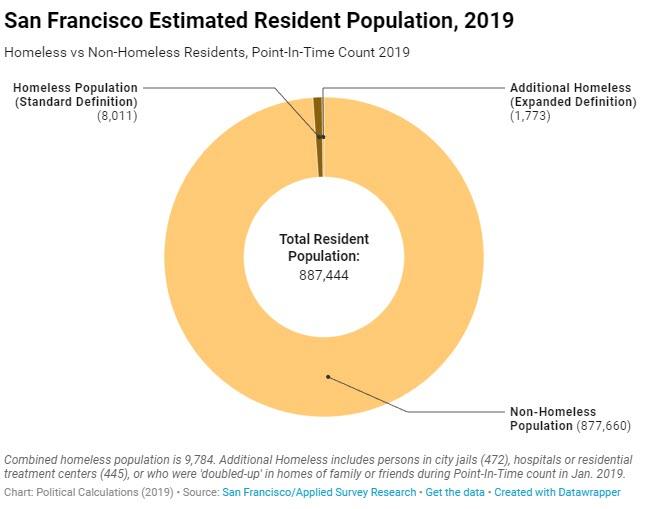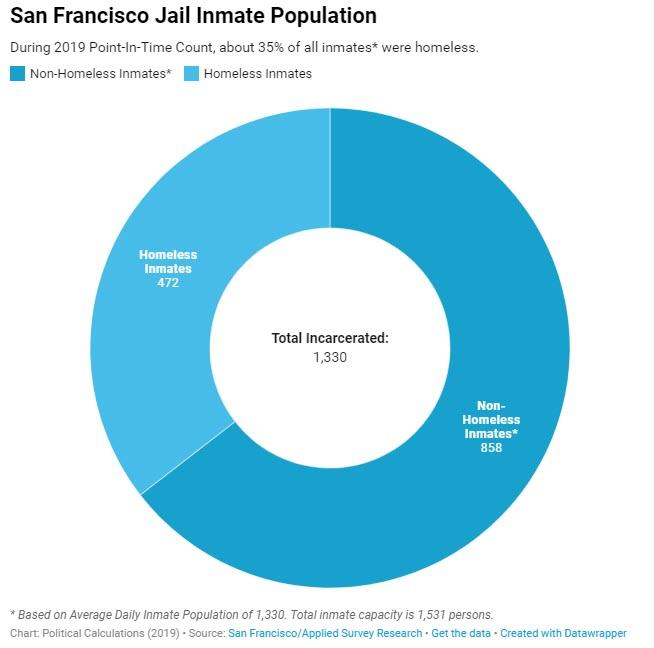Via Political Calculations blog,
We came across a news story in the Los Angeles Times about San Francisco’s 2019 Point-In-Time count of its homeless population that caught our attention because it indicated that the total number of homeless counted in San Francisco in January 2019 wasn’t 8,011 as previously reported, but 9,784 after more accurately accounting for the “hidden homeless”. Here’s an excerpt:
Over the last several months, cities and counties across California have been releasing homeless counts. The results have been grim.
San Francisco was no exception. In May, the city released data that showed homelessness had jumped 17%. That was bad enough. Last week, a more complete accounting, known as a point-in-time count, showed the problem was even worse.
The count revealed that homelessness in a city that’s become a caricature of wealth inequality in the U.S. had actually increased by about 30% from 2017, when the last count took place.
The new numbers use a broader definition of what’s considered to be homeless that goes beyond what’s mandated by the U.S. Department of Housing and Urban Development. They include homeless people in jails, hospitals and residential treatment facilities.
Partly what stands out in this story is its bad reporting, because the figure behind the 17% increase in San Francisco’s homeless count that was reported in May 2019 and the figure behind the 30% increase reported last week were both the result of the city’s 2019 Point-In-Time Count of its homeless population. The difference between the two figures is who they include in their totals, where the claim that the later reported figure was the result of “a more complete accounting, known as a point-in-time count” is highly misleading.
The count of 8,011 homeless is based on a standardized definition of who should be counted as homeless that is set by the U.S. Department of Housing and Urban Development, which may be compared with data reported in other regions and for the same region in previous years, which makes the data valid for tracking trends across space and time. The higher count of 9,784 reflects the results of what we believe is a reasonable expanded definition of who should be counted as being homeless that is useful for better quantifying the true size of the city’s homeless population, which is specifically useful for directing how public officials and private relief organizations might use their limited resources to address problems related to the region’s full homeless population.
We can show how both these aspects matter by getting into the city’s actual report, rather of relying upon the LA Times account of it, where we started with the question: how many of San Francisco’s residents are homeless and how many are not?
The answers to these questions are shown in the following chart, which also confirms that 1.1% of San Francisco’s estimated population of 883,305 (as of July 2018) was counted as being homeless in January 2019:
The expanded definition of San Francisco’s homeless population includes 472 who were in jail during the period of the January 2019 Point-In-Time count, so we decided to focus on this subset of the city’s homeless population, where we wondered what percent of the city’s imprisoned population they made up.
While San Francisco’s four jails have a total capacity of 1,531 inmates, they hold an average of 1,330 inmates on any given day. Using that latter figure, the homeless would account for about 35% of the city’s average daily inmate population:
At this point, it would be nice to know if there is a changing trend with respect to the number of homeless San Franciscans being incarcerated in the city’s jails. The city’s report indicates that some 299 homeless people were incarcerated in the city’s jails back in January 2017, however the 2019 report also indicates that the homeless count survey’s methodology significantly changed between 2017 and 2019. As such, rather than comparing apples-to-apples, the 2017 and 2019 data for the city’s jailed homeless represent more of an apples-to-oranges comparison, where the two figures cannot be used to establish if any trend exists. Standard definitions matter for this reason.
One thing stands out to us in this data is the apparent rate of incarceration for San Francisco’s homeless population. While 4.8% (about 1 in 20) of the city’s homeless were residing in the city’s jails in late January 2019, that’s a relatively huge fraction of the base population compared to the incarcerated share of 0.1% for the city’s non-homeless population.
The following chart expresses these percentages as the number of inmates per 100,000 of each group’s base population, where we confirm that San Francisco’s homeless were 49 times more likely to be in jail than the city’s non-homeless population at the time of the city’s 2019 Point-In-Time count of its homeless population.
That’s fascinating because the city has been seeking to close one of its jails and has been implementing progressive reforms to its criminal justice system to make that possible through reduced arrests and prosecutions. In the absence of more effective law enforcement, property crimes and low-level offenses have spiked in San Francisco, making it all-but-impossible for the city officials to follow through their jail-closing ambition.
But perhaps it could if it more effectively addressed the problems posed by its homeless population and the problems that made them homeless in the first place. As it is, San Francisco’s leaders seem to have made the very expensive choice to effectively dedicate a large portion of its available jail space to house about 5% of its homeless population without doing anything to reduce any of the city’s crime. With the expanded numbers better describing the city’s homeless population, they can develop better solutions than they have done to date to deal with all these problems.
What do you suppose the numbers would look like for Los Angeles if that city performed its own expanded count of its very large homeless population?
via ZeroHedge News https://ift.tt/30KPznG Tyler Durden


